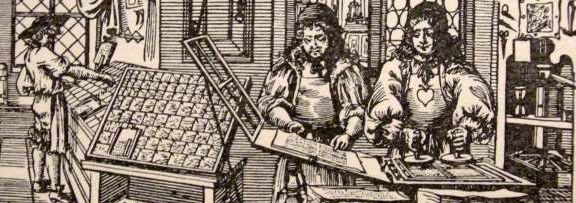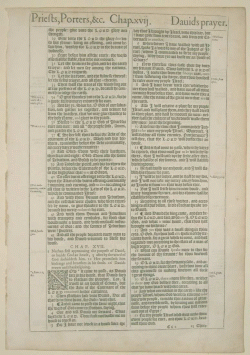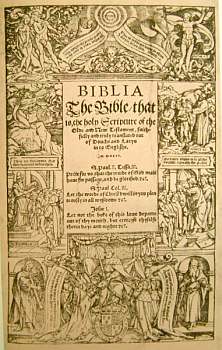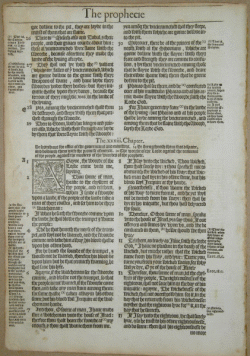
| Presented for sale by Phil Barber, Cambridge, Mass. 02139 Telephone (617) 492-4653 |
|
|
 | ||||||||||||||
|
.
RIGHT. Titlepage of the first printed English translation of the Bible, Marburg, Germany, 1535. Less than 65 copies, all defective, survive today. Translation into vernacular tongues began in 1466, with the first German Bible, and within two decades ten different language versions of the Bible were in print. But the first English language translation did not appear until Tyndale's New Testament of 1525, which was immediately suppressed. Another ten years would pass until Miles Coverdale produced the first complete English Bible in 1535. The sixteenth century would see a number of important translations, and early in the 17th century the great King James version became standard for Protestants while at the same time English-speaking Catholics too were able for the first time to read the Scriptures in their own language in the Douay Bibles. I am proud to present in this catalog fine representatives of these great early English translations. See also my other leaf catalogs for early Bible leaves in Hebrew, Latin, Greek, and several other languages, as well as other fine early imprints in English. For more information about early printing and how to collect and care for leaves, please select here. About This Catalog
No complete Bibles were vandalized to obtain these fine leaves. Rather, signatures or individual pages were rescued from books that were incomplete, or otherwise defective, in accordance with the generally accepted principles of the antiquarian book trade, which state " if a book is already incomplete, it is considered acceptable to remove and sell parts of the book." Edwin V. Glaser, quoted in A B Bookman's Weekly. Don't be astonished by my low prices, these are the finest quality original leaves that are obtainable, and which you might find elsewhere priced at much greater cost. It is my policy to price my items based on what I believe to be their fair market value. I do not set prices at absurdly inflated levels to take advantage of novices or "investors"; nor do I employ the common ploy of starting with an unrealistically high price in order to "negotiate" a phony discount later. It has always been my policy to present my catalog items at "wholesale to the public" prices. Therefore all catalog items and quoted prices are net, and are not subject to further discount, either for dealers or in consideration of quantity orders. As over a third of our catalog orders are from dealers buying for resale, at our stated prices, we have every confidence that this policy maintains an ethical standard of integrity and fairness to all. Pictures of Cataloged Items
Please note that the camera flash tends to exaggerate foxing and spotting, some degree of which is normal in old paper and which is not so dramatic in person!
Your comments are always welcome, as are your inquiries, if you have questions about these remarkable historic collectibles. We value our customers, and appreciate the confidence you place in us when ordering from our on line catalogs. We strive to merit your patronage and to enrich your collecting experience through accurate, knowledgeable descriptions, honest pricing, courteous service, and timely order filling. Our Glossary of terms web page may be reviewed for definitions of the descriptive terminology used in our catalogs and in the rare book trade generally. You can go to our e-mail want list form for special requests. Enjoy your browsing!

The result was titled The Byble in Englyshe of the largest and greatest volume...by commaundement of oure moost redoubted prynce and soueraygne Lorde, Kynge Henry the viii supreme head of this his churche and realme of England...This translation departs from the Germanic idioms derived from Luther and uses more Latin-based phrases, foreshadowing the Authorised translation of 1611. This work is also known as "Cromwell's Bible", as Coverdale worked under his direct patronage, or as "Cranmer's Bible" although the Archbishop is thought not to have been involved in the work apart from contributing his Prologue, which first appeared in the April, 1540 edition.
Seven essentially identical editions of the Great Bible were printed at London in 1540 - 41, in conformity with Henry VIII's royal order instructing every clergyman in the Kingdom to provide "one boke of the whole Bible of the largest Volume in Englysshe and have the same sett up in summe convenient place within the churche that he hath cure of, wherat his parishoners may most commodiously resort to the same and red yt." This Bible uses the original method of dividing the verses into chapters and lecterns, following Hugo de St. Cher's standard revision of Jerome's Vulgate translation. Please note that the designation of contents in my descriptions departs slightly from the modern convention of chapter and verse notation, which had not yet been devised when this edition was printed.
We are proud to be able to offer specimens of this very important and quite rarely offered early English Bible. Printed in an unusually large Black Letter type, the leaves are as visually inspiring as their content, which is in the charming idiom of sixteenth century old English. The leaves are large folio size with double columns of English language text in large Black Letter type.
I. Leaves from the Sixth Impression, printed November, 1541, measuring 10" x 14¼"; referenced in Herbert, The English Bible, as no. 62.
SOLD OUT

 ABOVE. Scene in a 17th century Dutch printing shop. Contemporary engraving

| ||||||||||||||
 Original leaves from the true Second Folio of the King James Bible. There had been two distinct impressions of the first edition, one printed in 1611 and the other published in 1613. The publication of the latter, which is often called the "Great She Bible" for a misprint in Ruth iii.15, was delayed by Barker for reasons that remain unclear. Apparently some of the 1611 leaves were combined with a new run of leaves printed in identical format in order to produce a few more complete copies. Fry (in A Description of the Great Bible...London, 1865) lists at least four separate revisions of that work, Herbert entry number 319.
Original leaves from the true Second Folio of the King James Bible. There had been two distinct impressions of the first edition, one printed in 1611 and the other published in 1613. The publication of the latter, which is often called the "Great She Bible" for a misprint in Ruth iii.15, was delayed by Barker for reasons that remain unclear. Apparently some of the 1611 leaves were combined with a new run of leaves printed in identical format in order to produce a few more complete copies. Fry (in A Description of the Great Bible...London, 1865) lists at least four separate revisions of that work, Herbert entry number 319.This second edition was put to press shortly after the final supplies of 1611 leaves had been exhausted. The First edition appeared in 56 line format, while the present printing was produced in distinctive 72 line format. This scarce edition displays the large format, superb typography and lavish attention to decorative detail that graced the first edition of 1611-13, which was the work of the same printer, Robert Barker, the official printer to the Curt of King James. Reference: Herbert (The English Bible) number 322. Considered the greatest example of English prose, the King James translation profoundly affected English language and culture for over three centuries. The aim was not to produce a new translation, but to make a good one better'. The Bishops' Bible was taken as a basis and compared with the original tongues and with Tyndale, Matthew, Coverdale, the Great Bible and the Geneva. They also used (though they kept this dark) the Rhemes New Testament. During the previous century immense advances in Biblical scholarship had been made throughout Europe by Protestants, Catholics and Jews. More accurate texts were available, far better grammars and dictionaries had been produced, kindred languages such as Syriac and Aramaic were better understood. In England itself the study of Hebrew had made great strides. About 90 per cent of Tyndale's work and a great part of Coverdale's, survive in the Authorized Version. The Geneva and Rhemes versions, in their different ways, brought a new accuracy to the translation. The Geneva provided pithy phrases, while Latinisms from Rhemes contributed to the majesty of the prose. It has been compared to a great English cathedral: not the work of one period alone, but due to the devoted creation of several generations. It was indeed fortunate that this majestic translation was achieved during one of the most creative periods in English literature, when the English language as we know it was growing out of medieval usage into prose that rolls like a great cathedral organ played by a master- musician. Macaulay said: 'If everything else in our language should perish it [the Authorized Version] alone would suffice to show the whole extent of its beauty and power.' No book has had greater influence on the English language or on the English character. For the next three hundred years the majority of English men and women heard it read aloud Sunday after Sunday and, until within living memory, a very large proportion of people read the Bible with steady, life-long devotion in their own homes. And this great quality was carried to America, where its influence has hardly been less. Sold out at Present |
 About This Era and Its Bibles
About This Era and Its Bibles









 Quarto size, measuring 6½" x 8¾". The Geneva-Tomson-Junius version of the sacred scriptures, the final Barker printing of a very long series. The Geneva Bible first appeared in 1560, the work of reformers who had fled to Geneva to escape persecution in England during the reign of Queen Mary. This very influential translation went through some 140 editions over an eighty year period. The new King James Translation of 1611 proved immediately popular and soon came to replace the faithful old version which had inspired Shakespeare and the greats of Elizabethan England. The present example is the last Roman Letter quarto to be produced by the King's official printer. This leaf carries the text of one of the Books of the Old Testament. Double Columns of Roman Letter English language text with Roman Letter sidenotes. Reference: Herbert, The English Bible, no. 342. Condition is exceptionally clean, lovely bright fine . . . 10.00
Quarto size, measuring 6½" x 8¾". The Geneva-Tomson-Junius version of the sacred scriptures, the final Barker printing of a very long series. The Geneva Bible first appeared in 1560, the work of reformers who had fled to Geneva to escape persecution in England during the reign of Queen Mary. This very influential translation went through some 140 editions over an eighty year period. The new King James Translation of 1611 proved immediately popular and soon came to replace the faithful old version which had inspired Shakespeare and the greats of Elizabethan England. The present example is the last Roman Letter quarto to be produced by the King's official printer. This leaf carries the text of one of the Books of the Old Testament. Double Columns of Roman Letter English language text with Roman Letter sidenotes. Reference: Herbert, The English Bible, no. 342. Condition is exceptionally clean, lovely bright fine . . . 10.00




